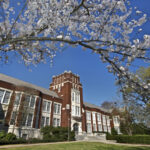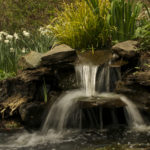Whitman-Walker Healing Garden
Cultivating hope for an HIV clinic and its community
In the mid-90s, when people were still nervous to be around those infected with HIV/AIDS, the Whitman-Walker Clinic of Northern Virginia moved to a new location. The new building looked out onto a sizable area of overgrown woodland, strewn with trash and concrete slabs. Clinic staff envisioned transforming this dismal landscape into a beautiful space for patients struggling with a new reality to experience hope and encouragement—The Whitman-Walker Healing Garden. A healing garden committee consisting of landscape designer Geof Lindstrom, sculptor Caroline Hufford-Anderson, labyrinth coordinator Karen Rowe and a host of volunteers made it happen, with a little help from Nature Sacred.

A grim environment goes green
These Firesouls knew they had a rough road ahead. The clinic was in a cinderblock building with an overgrown plot of land behind it. Inside was a tiny waiting room where people sat side by side, miserable and scared. Because the clinic was on a shoestring budget, there were no resources to enhance the experience for patients and their loved ones just when a more inviting environment would have meant so much. And because the clinic’s central office was afraid the committee’s efforts might divert donor dollars from the services they provide, they received no support or money from them.
But they weren’t deterred. They got a grant and started by clearing a small area and putting in a patio and seating wall. That led to a waterfall and a small pond.
A life of its own
And the momentum kept growing. The Whitman-Walker Healing Garden seemed to take on its own energy and life. Geof had been afraid they wouldn’t be able to mobilize others to help. But help always appeared when they needed it.
Volunteers logged in hundreds of hours. Gays and lesbians worked side by side with heterosexual volunteers. Local businesses and individuals made generous contributions. A tree service company donated their services, trimming branches, removing dead trees and stumps. A neighborhood resident donated a 20-year-old weeping Japanese maple tree with a one-ton root ball. Additional plants would appear, as people dropped by and planted them.

Next on deck was a large space that was still a mess, full of poison ivy and weeds, an irrigation system, lights for nighttime use and a labyrinth, a key feature of a Nature Sacred space.
The labyrinth—a safe space
The labyrinth has three boulders in the center, which act as a fulcrum of strength and have an anchoring effect. They also provide a resting place for those who are ill or weak and need to sit as they walk the labyrinth. The boulders were intentionally place in a symbolic triangle, representing both the gay triangle and the Holy Trinity. Three boulders outside the labyrinth echo the three in the center, imbuing the walker with the feeling of being held and protected. This feeling of being encompassed and safe is present throughout the whole garden.
“The garden represents peace and comfort. I come here to find purpose in life, and the garden helps.” – Journal Entry
Clinic staff uses the labyrinth. At first, some were skeptical. But when a funding crisis threw the clinic’s future into uncertainty, and with it the future of the staff’s jobs, the staff’s own anxiety made it harder than usual to handle their clients’ suffering. So they began visiting the garden and labyrinth themselves. And new staff members often say they chose to work at this particular clinic because of the beautiful garden and labyrinth.
“Walking the labyrinth regularly will clear your mind and spirit and make room for the new.” – Journal Entry
Local churches, civic groups and schools also frequent the Whitman-Walker Healing Garden. This fulfill’s the second goal the healing garden committee had for their sacred space: to forge a bond between the clinic and the community.
Bridging between clinic and community

When the garden was conceived, people were still nervous about being around anybody with AIDS or being associated with anything that had to do with AIDS. AIDS will go down as one of the greatest epidemics of our time, and its stigma spread as fast as the infectious disease itself.
There were a lot of walls then. Walls of secrecy around those with HIV/AIDS that kept them isolated and walls that people in the community put up to separate themselves. The committee hoped to break down some of those walls by creating a place of beauty and peace that’s open to the community and encourages people to come to clinic grounds, use the space and, hopefully, learn more about the illness.
The desire to be healed and whole
Another unique feature of this garden is a six-feet-high wrought iron sculpture that serves as the portal to the labyrinth. It symbolizes the biblical story of King David, who was devastated with grief over his son Absalom’s death. The sculpture stands as a metaphor for moving through grief to acceptance. Sculptor and Firesoul Caroline Hufford-Anderson became one of this project’s most passionate advocates after her son died of AIDS. She believed the theme of loss is universal, as is the desire to be healed and whole.
And that’s why Geof felt the sculpture touches everyone who enters the Whitman-Walker Healing Garden. In designing and building this Nature Sacred place, he also realized it was important to listen to what the garden said it should be. And this garden spoke to them very clearly. In the end, they felt a sense of wonder at how it came together virtually without conflict, and with every person essential to its success.
“The Whitman-Walker Healing Garden has allowed people—clinic staff, clients, people in the community—to see the power of possibility,” Firesoul Geof Lindstrom.
The very best kind of success story
What happened next was really astounding—and a true testament to the affinity people had for the space.
Over the years, the needs for the clinic had changed—due to changes in healthcare coverage, new mobile methods for treatment, and the economic downtown of 2008 was turning out more people without insurance—to name a few reasons. In short, the labyrinth and garden was set to close—one of many changes the clinic was undergoing at that time.
Those impacted by the labyrinth and garden asked the Arlington Recreation and Parks department to store the stones, which were “pried from the earth when the clinic closed in 2009, the pieces of its seven-circuit path of contemplation painstakingly numbered and stored in a county warehouse until three acres of land became available*” at a new, 3-acre site also in Arlington at Barton Park. * Source
Enter two new Firesouls from Recreation and Parks! It was arduous work—and not a little challenging, as some of the stones numbers (marked in chalk) had worn off. Stone by stone, they replaced the labyrinth exactly as it was laid out at Whitman Walker, to honor the healing that took place on it for many years. Truly amazing! [Image source]





